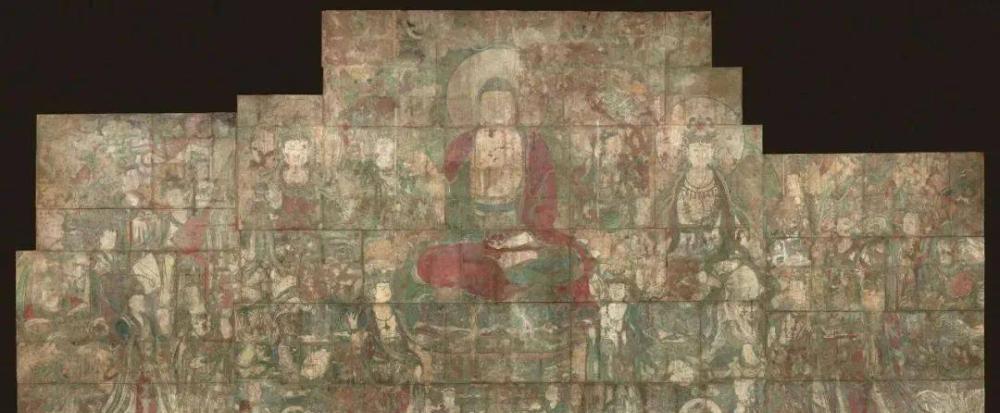01
In 1928, in Hongdong County, Shanxi Province, several cultural relics dealers got together and smashed a national treasure mural into more than 100 pieces, and sold it to the Americans for $400. When the local county magistrate and squire heard about it, they did not stop it, but deeply participated in it. The great monk who carried out this matter was not ashamed and erected a monument to himself to commemorate the merits.
This reselled mural is the "Blazing Light Buddha Buddha Society" at Guangji Temple in Shanxi.
This painting was painted in the Yuan Dynasty, upside down and displaced for a lifetime, and the "Drawing of the Blazing Light Buddha" in the Nelson-Atkins Art Museum in the United States is the largest mural in the world' paintings on the subject of the Blazing Light Buddha, with the most scenes, the most characters and the most magnificent momentum.
People worship the blazing light Buddha, praying for disasters to ward off evil spirits and calm down evils, but they do not think that the Buddha is also difficult to protect himself.

02
In 1928, The American cultural relics dealer Warner took advantage of the Nationalist government's self-care and plundered antique cultural relics on the North China Plain. When I heard that there were murals in Guangji Temple, I began to think crookedly. He contacted the local gentleman Li Zongzhao and expressed his desire to acquire the mural.
At that time, the Guangji Temple, which had been in turmoil after the war, was also in dilapidated, and there was no incense for many years, and there was only one monk with the name of Zhenda in the whole temple. The once golden and splendid Daxiong Treasure Hall is on the verge of being dumped every day. Zhenda did not have the heart to chant the sutra and chant the Buddha, but only prayed that the main hall and the temple wall would not fall down one day.
Li Zongzhao approached the monk Zhenda and discussed with him that Warner wanted to acquire the murals. The zhenda monk was already suffering from the lack of incense, and the temple was broken, so he thought about "selling the son to save the mother", thinking: "If I don't sell it, it will fall, and if it falls, it will be completely destroyed, but it is better to sell it now, make a sum of money, and still repair the temple."
The county magistrate of Zhaocheng County was overjoyed to hear that some Americans wanted to sell murals. It turned out that this Zhenda monk had already run to the county government several times and asked for money to build the temple. The county magistrate has not given it on the grounds of financial constraints, and now someone wants to buy the mural, and it just so happens that zhenda of the province will be in trouble later.
The 180-square-meter giant mural was sold to the Americans for $400, equivalent to 1,600 silver dollars in China. Warner immediately unloaded eight pieces of the mural into more than 100 pieces, loaded them into containers, and shipped them to the United States.
The Zhenda monk got the money, repaired the temple, and erected a monument to himself, recording his "great achievements." The inscription reads:
"The Buddhist temple building under the mountain has collapsed over time, and Yi frequently wants to repair it, but it is stopped because of the huge amount of money." Last year, there were distant visitors, the wall painting of the Buddha Temple, the Bogu people are elegant, and the price can be worth more than a thousand gold. The house of representatives thought that the construction of the temple was not funded, and because of repeated discussions with customers, they sold 1,600 yuan of silver oceans. ”
03
However, the Zhenda monk repaired the Guangji Temple and could not continue to stay, and after a few years, he returned to the customs and married his wife and had children.
After Warner shipped the murals to the United States, americans regarded them as treasures. A "Chinese Temple" exhibition hall was built at the Nelson-Atkins Museum of Art to display this magnificent "Blazing Light Buddha". A number of American sinologists such as Schkemen have conducted meticulous research on this mural and published a large number of research papers.
The center of the composition of this "Blazing Light Buddha Buddha's Society" is the "Three Buddhas". According to tradition, when the left and right are held as "Sunshine Bodhisattva" and "Moonlight Bodhisattva", the main figure in the middle should be "Medicine Buddha", but the main figure of this mural is "Blazing Light Buddha". The mural also depicts a complete "Eleven Yao" star gods and other saints, which is the most complete "Blazing Light Buddha's Buddha's Society" in existence.
In the backward era, I don't know how many cultural relics have been lost overseas, but we should also be thankful that these cultural relics were not destroyed in the war, and future generations still have the opportunity to see the real face.